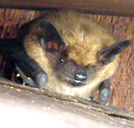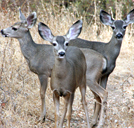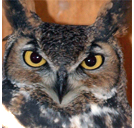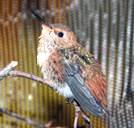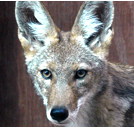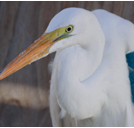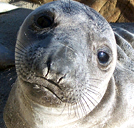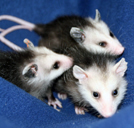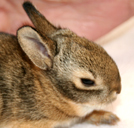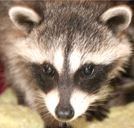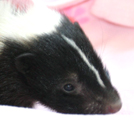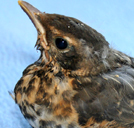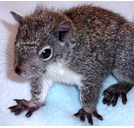BAT FACTS
What to do if you find a Bat
If you have found a bat and are in need of immediate help, please click here for information courtesy of Bat World Sanctuary
(link: http://www.batworld.org/what-to-do-if-you-found_a_bat/)
How to Coexist with Bats
Please see information courtesy of Bat World Sanctuary: http://www.batworld.org/bat_problems/
About Bats (Order: Chiroptera)
Bats are flying mammals in the order Chiroptera. Chiroptera comes from two Greek words, cheir “hand” and pteron “wing.”
The forelimbs of bats are webbed and developed as wings, making them the only mammals naturally capable of true and sustained flight.
Bats do not flap their entire forelimbs, as birds do, but instead, flap their spread-out digits, which are very long and covered with a thin membrane or patagium.
There are about 1,240 bat species worldwide, which represent about twenty percent of all classified mammal species.
About seventy percent of bats are insectivores. Most of the rest are frugivores or fruit eaters. A few species such as the Fish-eating Bat feed on animals other than insects, with the vampire bats being the only mammalian parasite species.
Bat Facts
Bats are present throughout most of the world and perform vital ecological roles such as pollinating flowers and dispersing fruit seeds. Many tropical plant species depend entirely on bats for the distribution of their seeds.
Bats are found in almost every habitat available on Earth. Different species select different habitats during different seasons. Bat habitats have two basic requirements: roosts, where they spend the day or hibernate, and places for foraging. Bat roosts can be found in hollows, crevices, foliage, and even human-made structures; and include “tents” that bats construct by biting leaves.
Although the eyes of most bat species are small and poorly developed, leading to poor visual acuity, none of them are blind. Vision is used to navigate mostly for long distances when beyond the range of echolocation. It has even been discovered that some species are able to detect ultraviolet light. They also have a high-quality sense of smell and hearing.
Bats hunt at night to avoid competition with birds, and travel long distances (at most 800 km), in their search for food.
Almost three-fourths of the world’s bats are insect eaters. Insects consumed by bats include both aerial insects and ground-dwelling insects. Each Bat is typically able to consume one-third of its body weight in insects each night, and several hundred insects in a few hours. This means that a group of one thousand bats could eat four tons of insects each year. If bats were to become extinct, the insect population is calculated to reach an alarmingly high number.
DUCK FACTS
Ducks
What to do if you find a Mallard?
If you have found a duck and are in need of immediate help, please click here for information.
Adult Mallards
For advice on injured or sick adult ducks, follow the same guidelines in the Marine & Seabird Section.
Baby Mallards
If you have rescued orphaned ducklings, they will need immediate care from a licensed rehabilitator who will raise them to be wild and return them to their environment when they are ready.
Because they are usually kept very warm (under Mother) when they are tiny chicks, the ducklings need to be placed in a warm, safe environment while they await transport and care at a facility. This can be accomplished simply by placing the chicks in a box with absorbent material on the bottom (newspaper works well) and by placing the box half on and half off of a heating pad set on low.
Do not allow baby ducklings to swim. Please make sure they stay as dry as possible because they can quickly get hypothermic (chilled) and die. If you can’t get them to a rehabilitator right away, you can give them water in a shallow lid (like a peanut butter lid) filled with small rocks. This should allow them to drink but prevent them from getting wet.
How to Coexist with Ducks
Ducks in Pools
There are several ways to keep migrating ducks and ducks preparing to nest from taking up residence in your pool or backyard. Discouraging nesting and residency before they occur is easier than solving these problems once they have occurred.
- Do not leave out food that the ducks might eat. This is the number one way to discourage the ducks from staying around your pool or backyard.
- Brightly colored objects floating freely in the pool, such as a beach ball or other floating pool toys discourage ducks.
- Cover the pool during migration – a few weeks during the fall.
- Ducklings that have fallen into a pool will not be able to climb out with the steep pool edges. Help them climb out by improvising a ramp from the water to the pool edge.
- The easiest ramp to build is made from a piece of Styrofoam/kickboard/small boogie board and a large bath towel. Wet the towel (to increase its weight), then float the Styrofoam/kickboard/small boogie board at the edge of the pool and drape half of the wet towel over it. The other half of the towel should be draped over the edge of the pool. It can be weighted down with a brick if needed. The styrofoam will serve as a floating dock that the ducklings can jump onto. The towel will allow them to make their way over the edge of the pool.
Mallard Breeding
Mallards usually form pairs (in October and November) only until the female lays eggs at the start of nesting season which is around the beginning of spring (early March to late May), at which time she is left by the male who will join up with other males to await the molting period which begins in June.
The nesting period can be very stressful for the female; since she lays more than half her body weight in eggs and requires a lot of rest and a feeding/loafing area that is safe from predators. When seeking out a suitable nesting site, the female’s preferences are areas that are well concealed, inaccessible to ground predators, or have few predators nearby. This can include urban areas that have roof gardens, enclosed courtyards, and flower boxes on window ledges more than one story up, which prevents the ducklings from leaving safely without human intervention. The clutch is 8–13 eggs, which are incubated for 27–28 days to hatching with 8-10 weeks to fledging.
The ducklings are precocial and fully capable of swimming as soon as they hatch. However, imprinting will compel them to instinctively stay near the mother not only for warmth and protection but also to learn about and remember their habitat as well as how and where to forage for food. When ducklings mature into flight-capable juveniles, they will learn about and remember their traditional migratory routes.
About Mallards (Anas platyrhynchos)
- The Mallard is a dabbling duck which breeds throughout the temperate and subtropical Americas, Europe, Asia, and North Africa, and has been introduced to New Zealand and Australia.
- The Mallard is 22–26 in long (of which the body makes up around two-thirds), has a wingspan of 32–39 inches, and weighs 32–42 oz.
- The breeding male is unmistakable, with a bright bottle-green head, black rump and a yellowish orange (can also contain some red) bill tipped with black. He has a white collar that demarcates the head from the purple-tinged brown breast, grey-brown wings, and a pale grey belly.
- The female Mallard is a mottled light brown, like most female dabbling ducks, and has buff cheeks, eyebrow, throat, and neck with a darker crown and eye-stripe. She also has a blue patch on the wings.
Mallard Facts
- The Mallard is omnivorous and very flexible in their food choice. The majority of the Mallard’s diet seems to be made up of gastropods, invertebrates (including beetles, flies, lepidopterans, dragonflies, and caddisflies), crustaceans, worms, many varieties of seeds and plant matter, and roots and tubers.
- The Mallard lives in wetlands and is gregarious. They are also migratory.
- The Mallard is the ancestor of most domestic ducks and can interbreed with other species of genus Anas. However, a potentially terminal side effect of this vast interbreeding capability is gradual genetic dilution, which is causing rarer species of ducks to become at risk for extinction.
DEER FACTS
Deer
What to do if you find a Deer or Fawn
If you have found a deer or fawn and are in need of immediate help, please click here for information.
How to Coexist with Deer
- Deer-proofing: To get a list of deer-resistant trees and shrubs, write to the Resources Agency of CA Department of Fish and Game.
- Hang bags of human hair in trees and shrubbery that you don’t want deer to consume.
- Be alert and drive carefully in areas where deer are likely to be present.
- If you see a fawn lying still on the ground or walking around without its mother, leave them where they are.
- If the situation is such that you feel the fawn’s mother has been killed, call CWC.
- Do not ever try to take a fawn home to raise them yourself.
About Mule Deer (Odocoileus hemionus)
- Native to western North America
- Browser rather than grazer; primarily eats shrubs
- Crepuscular (dawn and dusk active)
- Rutting (mating) begins in October
- Fawns are born in April-June
- Excellent swimmer
- Two-toed ungulate (hoofed animal)
- Bony antlers in the male
- Antlers shed annually
- Long and mobile ears
- Ruminants-digest food like a cow
Mule Deer Facts
- Natural predators of deer have been reduced in numbers (mountain lions, coyotes)
- Populations decline due to fragmentation, degradation, or destruction of habitat caused by urban expansion and human interaction
- Imprinting of fawns to humans: Imprinting on a person can lead to future association with people after release and lack of interest in breeding with their own kind; usually leading to the animal’s death
HAWKS & OWLS(RAPTOR) FACTS
Hawks and Owls (Raptors)
What to do if you find a Hawk or Owl
If you have found a hawk or owl and are in need of immediate help, please click here for information.
How to Coexist with Raptors
- Keep cats and small dogs indoors.
- Hawks are good at keeping the rodent population in check. You can also put up an “owl box” in your backyard to provide a home for some owls to also help reduce the rodent population.
- Drive slowly at night, taking care to look for owls and other wildlife.
- Put a chimney cap or wire mesh over your chimney so owls don’t nest there or fledge into your chimney.
- Don’t use poison to kill rodents; you may inadvertently kill hawks, owls, and other wildlife that prey upon rodents.
- Keep domestic birds inside, avoiding outdoor cages, or simply use small gauge wire.
About Red-Tailed Hawks (Buteo jamaicensis)
- Adaptable, common, and widespread in almost all habitats in Southern California
- Red-tailed hawks are in the group of birds known as raptors or birds of prey
- They have a strong, hooked beak
- Typically weighs 2-3 lbs.; with the female nearly 1/3 larger than the male
- Diurnal (Day active)
- Carnivore-eats mostly small rodents, birds and reptiles
- Eyesight is three times better than ours
- A red-tailed hawk can see a mouse ½ a mile away
- Can fly up to 40 mph
- They search for prey by soaring or perching
- Have been known to hover on thermal wind or air currents
- Red-tailed hawks have a hoarse and rasping 2-3 second scream that can be heard while they’re soaring
- Scrub jays and other predators sometimes take undefended red-tailed hawk eggs and nestlings
- Great horned owls and golden eagles commonly use old nests of hawks
Red-Tailed Hawks Facts
- In California, state and federal laws protect all raptors
- Because of their inexperience in hunting, juvenile birds may be seen eating road-killed animals
- Hawks may sometimes kill chickens. As a consequence, dead hawks hanging from fences and lying under trees and power poles are mute evidence that shooters, not understanding the economic or aesthetic importance of raptors, or perhaps unaware of protective laws, still kill them indiscriminately.
About the Great Horned Owl (Bubo virginianus)
- Name derived from tufts of feathers on ears that appear to be “horns”
- Prefers thickly wooded canyons
- Nocturnal (night-active) and Crepuscular (dawn and dusk active)
- Females are 10-20% larger than males
- Clutches prey by diving down from high perches
- Prey are usually killed instantly when grasped by the owl’s large talons
- Carnivorous; top predator; preying on rodents, rabbits, and birds
- A great horned owl can catch prey two to three times heavier than itself
- Eat their prey whole and regurgitate the indigestible parts (bones, fur, and feathers)
- Pellets are regurgitated 6 to 10 hours after eating
- Great horned owls have a large repertoire of sounds: from deep hoots to shrill shrieks
- Owls are solitary in nature; only staying with their mate while nesting
- Both males and females incubate their chicks
- There are recorded flying speeds of great horned owls of up to 40 mph
- Great Horned Owls don’t build nests of their own; instead, they use the nests of birds and squirrels or find hollows in trees and buildings
Great Horned Owl Facts
- Great Horned Owls are generally shy in nature; that and their ability to adapt enable them to remain fairly common
- Great Horned Owls are protected under the U.S. Migratory Bird Treaty Act
- They occasionally prey on domestic poultry and cats
- Great Horned Owls help to control harmful rodent populations
HUMMINGBIRD FACTS
Hummingbirds
What to do if you find a Hummingbird
If you have found a hummingbird in need of immediate help, please click here for information.
How to Coexist with Hummingbirds
If you have a hummingbird feeder:
- Do not place hummingbird feeders near a window. Although beautiful to watch, hummingbirds may fly to the feeder reflected in the window and injure themselves on the glass.
- Never use honey to make hummingbird food; always make the food with clean water and pure white sugar; 4 parts water to one part sugar.
- Change the feeder every couple of days to avoid bacterial growth and bleach with a 10% bleach solution. To try to prevent disease transmission between birds and in order to prevent them from becoming dependent on the feeders, it’s a good idea to take feeders down for a few days at a time and then put them back up.
- Keep your pet cat indoors if you have hummingbirds in your yard. Due to their tiny size, hummingbirds are easy prey to an agile cat.
About Hummingbirds (Order: Apodiformes)
- Hummingbirds are birds that comprise the family Trochilidae.
- They are among the smallest of birds, most species measuring in the 3–5cm in range.
- They can hover in mid-air by rapidly flapping their wings 12–90 times per second (depending on the species). They can also fly backward, and are the only group of birds able to do so.
- They can fly at speeds exceeding 15 m/s (34 mi/h).
- With the exception of insects, hummingbirds while in flight have the highest metabolism of all animals, a necessity in order to support the rapid beating of their wings.
- Their heart rate can reach as high as 1,260 beats per minute.
Hummingbird Facts
- Their English name derives from the characteristic hum made by their rapid wing beats.
- Hummingbirds drink nectar, a sweet liquid inside certain flowers. Like bees, they are able to assess the amount of sugar in the nectar they eat; they reject flower types that produce nectar that is less than 10% sugar and prefer those with higher sugar content.
- Nectar is a poor source of nutrients, so hummingbirds meet their needs for protein, amino acids, vitamins, minerals, etc. by preying on insects and spiders.
- They also consume more than their own weight in nectar each day, and to do so, they must visit hundreds of flowers daily. Hummingbirds are continuously hours away from starving to death and are able to store just enough energy to survive overnight.
- Hummingbirds are capable of slowing down their metabolism at night or any other time food is not readily available. They enter a hibernation-like state known as torpor. During torpor, the heart rate and rate of breathing are both slowed dramatically (the heart rate to roughly 50–180 beats per minute), reducing the need for food.
LARGE PREDATOR (Bobcat, Coyote, Fox, Mountain Lion) FACTS
What to do if you find a Large Predator?
If you have found a large predator (coyotes, fox, bobcat or mountain lion) in need of immediate help, please click here for information.
About Bobcats (Lynx rufus)
- Commonly mistaken for a lynx
- 11-33 lbs.
- The range is on average 15 square miles
- Long-legged for a cat, large paws
- Expert climber, swimmer, and powerful fighter
- Carnivorous; feeds mainly on rabbits and rodents
- Mostly nocturnal and crepuscular (dawn and dusk active)
- Spotted fur, tufted ears, short bobbed tail
- Known to crouch next to water troughs and streams and strike down bats as they fly low to drink
Bobcat Facts
- Bobcats are usually shy, yet they may not run away at first sight of a human
- Healthy bobcats are usually not an immediate threat to humans; they are only about the size of a cocker spaniel
- Growls and snarls are so deep that people sometimes think bobcats are mountain lions
- Bobcats are generally not persecuted as pest species in North America. They may occasionally raid poultry, but bobcat depredations are uncommon
- People have been killing bobcats, hunting and trapping them for pelts, for profit since 1730
- Because they primarily prey on rodents, bobcats are very valuable to the environment; they help to keep the rodent population down
About Coyotes (Canis latrans)
- Native to western North America
- Lives on the urban edge of Southern California communities, desert to mountains
- Mostly crepuscular (dawn and dusk active) and nocturnal; seldom diurnal (day-active)
- Intelligent predator
- Opportunistic omnivore (eats both animals and plants), but primarily eats rodents
- Often tracks prey using their sense of smell; stalks 20-30 minutes before pouncing
- Territorial pack animal
- Known to mate for life
- 20-30 lbs
- Woof softly, growl, bark, howl, and “sing” in a chorus
- Communicates with 11 different sounds, body language, and scent
Coyote Facts
- Adapting to urban areas as natural habitat shrinks, Coyotes can change their breeding habits, diet, and social dynamics to survive
- People feed coyotes -> coyotes lose the fear of people -> conflict between people and coyotes -> coyotes destroyed
For answers to specific Coyote Coexistence situations, please read our Coyote Coexistence Guidelines
About the Gray Fox (Urocyon cinereoargenteus)
- Prefers brushy, woody and scrubby terrain
- Can climb trees 10 feet or less- known as the “tree fox.”
- 5-14 lbs.
- Crepuscular (dawn and dusk active) and nocturnal
- Omnivorous (eats rabbits, rodents, insects, fruit, grains, and nuts)
- Related to the smaller Island Gray Fox (endemic to the Channel Islands)
- Territories are determined by family groups (parents and juveniles)
- Male fox will tend to juveniles, but not den with them
- Adults have few predators
- Juveniles fall prey to domestic dogs, golden eagles, hawks, and owls
Gray Fox Facts
- The gray fox has adapted well to urban environments; it can be found in almost any developed area that affords some degree of vegetation cover
- Urban foxes have a higher incidence of canine distemper than those in the wild due to their proximity to stray dogs; this is one reason urban foxes should not be relocated
About Mountain Lions (Puma concolor)
- Also called cougar, puma, panther, and catamount
- 7-8 feet in length
- 150-300 lbs.
- Can see about six times better than a human
- Carnivorous, solitary hunters; they spend most of their life alone.
- Their main prey in Southern California are mule deer.
- Natural habitat is steep, rocky, canyon country.
- Vocalizations include growls, hisses, screams, and roars
- Individuals develop a preference for one type of prey which limits competition among each other
Mountain Lion Facts
- Mountain lions are a protected species throughout the United States
- Mountain lion sightings in the Santa Monica Mountains are very rare due to diminishing numbers in California. Most people have actually seen a bobcat, deer, domestic cat, or coyote when they think they’ve sighted a mountain lion, however, if you’re sure you’ve seen a mountain lion, report it immediately to the Department of Fish & Game at 916.445.0045
- These cats have greatly diminished in number because they have lost habitats large enough to support them and because they have been bounty hunted (for sport, for their pelts, or to protect livestock)
- Mountain lions have proven relatively unable to adapt to habitat loss and competition with humans (their chief enemy) for large ungulate prey (deer). They hardly ever harm humans, although they will attack in self-defense or to protect their cubs
- Mountain Lions are territorial and will defend their established ranges, particularly at courtship time
- For tips on what to do if you encounter a mountain lion while hiking, and other information about pumas, go to the Mountain Lion Foundation’s website at www.mountainlion.org
MARINE & SHOREBIRD FACTS
Marine and Shorebirds
What to do if you find a Marine or Shorebird?
If you have found a marine or shorebird (cormorant, pelican, heron, egret, loon, grebe, or gull) in need of immediate help, please click here for information.
How to Coexist with Marine & Shorebirds
- Don’t approach or harass marine & shorebirds, especially near nesting sites.
- Don’t feed fish or any other food to marine & shorebird.
- Understand that if you use chum or baitfish, you will attract pelicans and other seabirds, as their natural prey is fish. After fishing, pick up used hooks and fishing line.
- You can also help by keeping pollutants out of the marine environment. Don’t dump toxic substances like oil, solvents, and other chemicals into waterways or into storm drains that lead to the ocean.
About Brown Pelicans (Pelecanus occidentalis)
- Average weight is 6 lbs, average wingspan 7 ft.
- Can live for 25-30 years
- Juveniles are brown with a white belly; they don’t acquire adult plumage until 3rd or 4th year
- Adults are grayish-brown with a white head, gray pouch, and black belly
- During breeding, pelican coloration changes to a yellow head and red pouch
- Birds can’t sweat; the pouch helps pelicans to cool off in hot weather
- Brown pelicans fly with their head held back in a “Z” over their back
- Make spectacular head-first dives from up to 60 ft high to prey on fish in the ocean
- Air sacs beneath the pelican’s skin cushion the impact and help them to surface
- Fish are swallowed head first; if necessary, the bird tosses it in the air to get the head positioned correctly
- The expandable pouch below the pelican’s bill can hold three times more than its stomach
- Breed on the ground on predator-free islands or treetops in coastal habitats
- Male pelicans gather materials for the nest, and the female builds it.
- Egg-laying typically occurs in March and April; incubation takes about one month.
- Both parents incubate the 2-3 white eggs and care for the young.
- Young pelicans feed on regurgitated fish from their parent’s pouches.
Brown Pelican Facts
- Brown Pelicans in California are recovering from low numbers in the 1970s, primarily due to habitat conservation and a reduction in pesticides, specifically DDT, in the food chain. The pesticide weakened eggshells and reduced breeding success
- Food availability is now a significant cause of concern for the brown pelican. The Pacific Mackerel, Pacific Sardine, and the Northern Anchovy are essential food for the pelican, especially during the breeding season. By the early 1900s, commercial over-harvesting of these fish had resulted in less food availability during this critical time
- Human development along the coast brings disturbance to the birds in their breeding and resting habitats. Nesting colonies are especially sensitive to human disturbance
- There is potential for a devastating oil spill from tanker traffic in the Santa Barbara Channel.
- Tanker traffic lanes are only a mile from a critical breeding colony at West Anacapa Island.
- Other human hazards that Brown Pelicans face include entanglement in fishing lines, ingestion of fishing hooks, and gunshot injuries.
- Brown Pelicans and fishers have conflicts arising from competition for fish.
- The brown pelican is protected under the Endangered Species Act; anyone found shooting, disturbing, or harming brown pelicans face prosecution from authorities
MARINE MAMMAL FACTS
Marine Mammals
What to do if you find a Marine Mammal?
If you have found a marine mammal (California Sea Lion, Northern Elephant Seal, or Pacific Harbor Seal), call the Marine Mammal Response Team and provide them with as much information as possible. 310-458-9453, option 1
How to Coexist with Marine Mammals
- Don’t approach or harass marine mammals. They are protected by the Marine Mammal Protection Act, and you could be subject to fines of up to $10,000.
- Don’t feed fish or any other food to marine mammals.
- Understand that if you use chum or baitfish, you will attract marine mammals, as their natural prey is fish. After fishing, pick up used hooks and fishing line.
- You can also help by keeping pollutants out of the marine environment. Don’t dump trash or toxic substances like oil, solvents, and other chemicals into waterways or into storm drains that lead to the ocean.
About California Sea Lions (Zalophus californianus)
- Carnivore (prey includes anchovies, squids, sardines, mackerel, rockfish)
- Habitat is shallow ocean water, rocks, and beaches
- Males are a chocolate brown color; females are a blonde color
- Face resembles a dog
- Have external ear flaps
- Adult males, on average, weigh up to 860 lbs., 7 ft. long
- Adult females, on average, weigh up to 240 lbs., 6 ft. long
- Southern California breeding occurs mainly on the Channel Islands in June
- Adult females give birth to one pup in late June
- Pups usually weaned six months-one year
- Males migrate to the Pacific Northwest after breeding; females stay around rookeries year-round
- Female distribution/range is from Baja, California to Northern California
- Communicate with noisy, honking barks
- Sharks are the sea lion’s natural predator in Southern California
California Sea Lion Facts
- Frequent Visitor To Marinas And Docks-Colonies Of Sea Lions Have Been Known To Sink Boats And Small Docks
- Sea Lions Often Approach Commercial Fishing Vessels, Following Their Prey That Has Been Caught In Fishing Lines And Nets; This Can Lead To Hook And Fishing Line Entanglement Injuries
- Sea Lions Are Common Victims Of Gun Shot Wounds And Blunt Trauma
About Northern Elephant Seals (Mirounga angustirostris)
- Carnivore (prey includes squid, octopus, and fish in very deep water)
- Habitat is open ocean
- Average dives are at a depth of 2,000 feet for 20 minutes
- Longest recorded dive by an adult female lasted 2 hours
- Deepest recorded depth by an adult male was 5,141 ft.
- Adult males, on average, weigh 4,400 lbs., 14 ft. long
- Adult females, on average, weigh 1,300 lbs., 10 ft. long
- Males develop a large, inflatable nose that can be up to one foot long.
- Mainly ocean-dwelling animals, only hauling-out to breed and molt
- Undergo a “catastrophic molt” once a year; they lose all hair and their top layer of skin.
- During their molt, they have to stay on the beach and don’t eat for up to two weeks.
- Coat color is light brown before molt, dark brown right after a molt
- Nearest rookery in Southern California is on the Channel Islands.
- One pup is born to females in late December or early January.
- Males establish territories for breeding in December; females arrive shortly after
Northern Elephant Seal Facts
- Elephant Seals were hunted almost to extinction by humans for their blubber in the 1880s; only a few dozen survived.
- The population is now over 150,000 due in part to the Marine Mammal Protection Act.
- Northern elephant seal skin disease most often affects elephant seals during their annual molt; the lesions from the disease can make them susceptible to bacterial and parasitic infections. The exact cause of the skin disease is unknown, but it is suspected that high levels of toxins (from chemical run-offs like PCBs) in their blubber may be the cause.
About Pacific Harbor Seals (Phoca vitulina)
- Carnivore (prey includes fish, crustaceans, octopus, and squid)
- Habitat is shallow ocean water, sandy and pebble beaches, intertidal rocks, and sandbars.
- Coat color varies from black with white spots to white with black spots.
- Do not have external ear flaps, but do have ear holes.
- Adult males, on average, weigh 370 lbs, 6 ft long.
- Adult females, on average, weigh 290 lbs, 5 ft long.
- Mate in the water in August
- One pup born in April-May
- Mothers leave their pups on the beach while they forage for food
- Adults are typically not vocal but may make grunting and snorting sounds to communicate
- Newborn pups vocalize with a repeated “maa” sound and growling noises
- Playful in the water; shy but curious
- Harbor Seal pups’ natural predators in Southern California are coyotes, foxes, and raptors
Pacific Harbor Seal Facts
- Harbor Seals are very afraid of humans and will abandon favorite haul-out sites and/or pups due to human presence
- Pups waiting for their mother on the beach are often thought to be orphaned and are then disturbed by well-meaning humans
OPOSSUM FACTS
Opossums
What to do if you find a Virginia Opossum
If you have found an Opossum in need of immediate help, please click here for information.
How to Coexist with Opossums
- Opossums will feed on human refuse, close garbage with tight lids, and pick up birdseed off the ground.
- Do not leave pet food or water outside.
- Secure dog doors and cat doors at night; this is often the way wildlife gets into homes.
- Place ammonia-soaked rags or mothballs in the area where opossums frequent in/near your home.
About Virginia Opossums (Didelphis virginiana)
- Only living marsupial native to North America
- Has a hairless prehensile tail that can grasp branches
- Too heavy to hang by its prehensile tail
- Natural habitats are deciduous forests and wetlands
- Nocturnal (night-active)
- Adults about the size of a domestic cat
- Predators are owls, foxes, and domestic dogs
- Solitary Opportunistic Omnivore (eats both animals and plants)
- Females can be very aggressive when protecting their babies
- When attacked, they play “possum” (act dead)
- Babies are born the size of a bee
- Females have a fur-lined pouch where babies crawl, grow and drink milk
Virginia Opossum Facts
- People fear opossums due to rabies, but they aren’t common carriers of rabies
- Opossums are generally shy and avoid people
- Raid garbage cans at night for food (opportunistic)
- Many opossums are killed on roads each year because they are often blinded by headlights
- Opossums are helpful by cleaning up dead animals (carrion) on the road
- They also help to control rodent and insect populations
RABBIT FACTS
Rabbits
What to do if you find a Rabbit
If you have found a Rabbit in need of immediate help, please click here for information.
How to Coexist with Rabbits
- Rabbits are rarely considered a great nuisance but may get into gardens and eat flowers and vegetables.
- Decorative rabbit-proof fencing is readily available at hardware stores.
- Bitter-tasting plants, such as marigolds, placed around the perimeter of the garden, may deter rabbits and other small animals from entering.
About Rabbits (Order: Lagomorpha)
- The rabbit’s long ears, which can be more than 4 in long, are probably an adaptation for detecting predators. They have large, powerful hind legs.
- The two front paws have five toes; the extra called the dewclaw. The hind feet have four toes.
- Their size can range anywhere from 8 inches in length and 0.4 kg in weight to 20 in and more than 2 kg.
- The fur is most commonly long and soft, with colors such as shades of brown, gray, and buff. The tail is a little plume of brownish fur (white on top for cottontails).
- Rabbits are prey animals and are therefore constantly aware of their surroundings.
- Rabbits have a very rapid reproductive rate. The breeding season for most rabbits lasts nine months, from February to October. Normal gestation is about 30 days. The average size of the litter varies but is usually between 4 and 12 babies, with larger breeds having larger litters. A kit (baby rabbit) can be weaned at about 4 to 5 weeks of age.
Rabbit Facts
- Rabbit habitats include meadows, woods, forests, grasslands, deserts, and wetlands.
- Rabbits live in groups, with some living in underground burrows, or rabbit holes. A group of burrows is called a warren.
- Rabbits are herbivores that feed by grazing on grass, forbs, and leafy weeds. In consequence, their diet contains large amounts of cellulose, which is hard to digest.
- They survive predation by burrowing, hopping away in a zig-zag motion, and, if captured, delivering powerful kicks with their hind legs. Their strong teeth allow them to eat and to bite in order to escape a struggle.
RACCOON FACTS
Raccoons
What to do if you find a Raccoon
If you have found a Raccoon in need of immediate help, please click here for information.
How to Coexist with Raccoons
- Secure garbage cans.
- Don’t leave pet food or water dishes out.
- Close dog and cat doors at night.
- For ponds, submerge a wire mesh horizontally around the circumference of the pond. Fish can then escape to the center of the pond, and raccoons will be discouraged from standing on the unstable mesh.
About Raccoons (Procyon lotor)
- Opportunistic omnivore (eats both animals and plants)
- Eats acorns, grains, nuts, fruit, and small animals
- Natural habitat is wooded and wetland habitats
- Nocturnal and solitary except when breeding or caring for young
- If water is close, raccoons appear to wash food
- The raccoon’s scientific name means “wash bear.”
- The goal isn’t to clean food but to tear at it, feeling for edible matter
- Has nimble fingers, can easily turn doorknobs
- When very cold, they may sleep for several days to a month (not hibernation)
Raccoon Facts
- Raccoons are very adaptable and tolerant of most human activity.
- Sometimes they consume fruits, vegetables, and other crops because natural habitat and natural food sources have been diminished.
- Domestic dogs may prey on raccoons.
- Raccoons can carry diseases, so they should never be touched by people.
- Foxes, bobcats, coyotes, owls, and other predators undoubtedly kill many young raccoons, but the automobile, disease, and human interaction are more significant causes of death
SKUNK FACTS
Skunks
What to do if you find a Skunk
If you have found a Skunk in need of immediate help, please click here for information.
How to Coexist with Skunks
- Keep garbage cans secure.
- Keep pet food and water inside.
- Mothballs sprinkled on the ground discourage skunks from digging up lawns for insects and visiting homes or campsites since they and many other small animals are repelled by the smell of camphor.
- If you see a skunk during daylight hours, it is probably sick.
- Since skunks can be rabies and leptospirosis vectors, do not attempt to catch the animal yourself, call a professional.
About Striped Skunks (Mephitis mephitis)
- Nocturnal (night-active)
- Omnivore-eats plants, insects, small mammals and amphibians
- 6-14 lbs.; male larger than the female
- Skunks are boldly colored to warn predators to stay away
- Anal glands are highly developed-can spray accurately up to 15 ft.
- Skunks do not spray unless mortally threatened
- They will usually arch their back, raise their tail, and stomp their front feet as a warning
- When spraying, forms a U-shape, lifting head and rump in the air
- The natural predator of the skunk is the great horned owl
- Skunks do not hibernate but can become temporarily dormant during extremely cold weather
Striped Skunks Facts
- Ammonia and gasoline work for removing the skunk’s scent out of clothing
- Carbolic soap and water are best for washing skin
- The best skunk spray removal uses one quart hydrogen peroxide, ¼ cup baking soda, and 1-2 tsp liquid dish soap mixed together in a bucket. Use this solution on pets, clothes, etc. Rinse and repeat if necessary.
- Pelts of the striped skunk are not highly valued, but the musk, once its odor is removed, is used as a perfume base due to its clinging quality
SONGBIRD FACTS
Songbirds
 What to do if you find a Songbird?
What to do if you find a Songbird?
If you have found a Songbird, please click here for dos and don’ts.
How to Coexist with Songbirds
- If you see a baby bird (nestling) fall from the nest, you can put it back into its nest immediately if there are no signs of injury
- If you see a fledgling (juvenile learning to fly) on the ground, leave it alone and bring your pets indoors for the next 3-5 days.
About Western Scrub-Jays (Aphelocoma californica)
- Natural habitat is oak woodlands and scrubby grasslands
- Back is gray-brown, belly is gray; head, wings, rump, and tail are blue
- Western Scrub-Jays living along the west coast have brighter blue upper-parts and whiter throats than birds from the interior portion of their range
- Adults are about 11-13 inches long
- Have a sturdy, dark bill that is sometimes used to hammer nuts open
- Omnivorous; eating mostly acorns, nuts, seeds, fruits, and insects
- Often eat the eggs or young of other birds, but in summer are mainly insectivorous
- One pair defends a territory about 7.5 acres large, year-round
- Breeding occurs from early March to mid-August.
- Monogamous; usually lay 2-3 eggs; Male feeds female while she incubates the eggs.
- The call is loud, throaty “jay” or “jree”. In flight, a long series of “check-check-check” notes
- Jays bury many more acorns than they consume and help regenerate oak forests that have been destroyed by fire or drought.
Western Scrub-Jay Facts
- In the early 1900s, many Western Scrub-Jays were shot in the name of crop protection.
SQUIRREL FACTS
Squirrels
What to do if you find a Squirrel
If you have found a Squirrel in need of immediate help, please click here for information.
How to Coexist with Squirrels
- Don’t trim trees in the spring; wait until fall to trim to avoid disturbing nests and babies. Check for nests before trimming trees.
- Don’t feed squirrels; keep birdseed off the ground.
About Western Gray Squirrels (Sciurus griseus)
- Natural habitat is oak and walnut woodlands
- Their range is from southern California to Washington, east to Nevada
- Native in southern California near or in local mountain ranges
- Also found in some of the less disturbed open areas that remain in the Los Angeles area
- Adult size up to 2 feet long, tail up to 1 foot long
- Long, bushy tail with bands of gray, white, and black
- Mainly eat pine nuts, acorns, and pine cones; will also eat buds, fungi, insects, and fruit
- Will bury acorns in the ground in summer, to dig up for food in winter
- Spend much of their time gathering and eating food, especially in preparation for winter
- Do not hibernate, but will put on weight and thicken their fur in anticipation of the cold
- Make nests of shredded bark and sticks called “dreys” at least 20 feet high in trees
- Will often build more than one nest and alternate among them
- Breeding occurs in January-May with about 3-5 young in one litter in March-June
- In late summer, will make hoarse barking calls
- Generally non-territorial and shy, with the exception of lactating mothers
Western Gray Squirrel Facts
- Once considered one of the most abundant mammals in the west in the 1920s, but mange, competition, and habitat loss have decimated many populations.
- While eastern gray and eastern fox squirrels produce more offspring in times of abundance to compensate for population loss in lean times, the western gray appears unable to, which limits its ability to rebound from low populations.
- Western grays appear to be less tolerant of people and development than their eastern cousins.
- Western grays are a federal Species of Concern but aren’t listed as threatened or endangered.
- The Forest Service considers western grays a “sensitive” species and a “management indicator species” in oak and pine forests.
- People hunt western grays in California and Oregon.
- Conservation groups in Washington state have petitioned the federal government to provide an emergency listing for this species.


